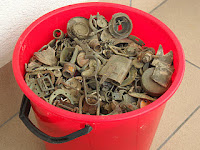7.1: Interpreting and Documenting Archaeological Information

The mere documentation of archaeological phenomena involves at every stage interpretation, whether something is a layer or feature, a disturbed or undisturbed context. Whether a soil change is anthropogenic or a natural discolourartion, or a natural layer. The documentation of a find will reflect this interpretation and depict it in written, drawn or other graphic form. This section cannot cover the whole topic of how the archaeologist observes, interprets and documents the archaeological record. The removal of archaeological evidence from an archaeological site, whether by excavation or other research process requires documentation. This is because the evidence that is embedded in the patterning of the material traces is destroyed as soon as it has been revealed, making it a mono-directional exploration. Keeping track of all the intermediate steps between the state at the beginning of the research and the deposition of the project archive is essential for the study of the site by




